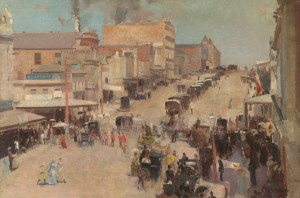Australia’s Impressionists
February 1, 2017
In December 2016, an exhibition of the works of Australia’s greatest Impressionist painters opened at the National Gallery, an art museum in London, England. The museum, home to a broad collection of paintings by mostly European artists, is showing 41 works by such Australian artists as Tom Roberts (1865–1931), Arthur Streeton (1867–1943), Charles Conder (1868–1909), and John Russell (1858–1930). “Australia’s Impressionists,” in collaboration with the Art Gallery of New South Wales, runs through the last Sunday of March 2017.

Tom Roberts’ Bourke Street West catches a bright glimpse of 1880′s Melbourne, Australia’s fastest-growing and largest city at the time. Credit: Allegro con brio, Bourke Street West (1885-6), oil on canvas by Tom Roberts; National Gallery of Australia, Canberra and the National Library of Australia
Much of the exhibit concentrates on the works of Charles Conder, Tom Roberts, and Arthur Streeton. These artists formed the backbone of the Heidelberg School, a group of painters who worked on the tree-covered hills overlooking the Yarra River in what is now the Melbourne suburb of Heidelberg. The group, later known as the Australian Impressionists, flourished from 1886 to about 1900. During that time, the group developed a distinctly Australian landscape style showcasing the continent’s light-filled outback and seacoasts as well as the sun-baked streets of Melbourne and Sydney.
The vibrant paintings of Sydney’s John Russell, who lived in France for much of his life, get an exhibit section to themselves. His works reveal the colorful influences of such contemporary European artists as Vincent van Gogh and Claude Monet. Russell’s paintings often portray the landscapes and rocky shorelines of Belle-Île, an island off the coast of Brittany. Russell’s paintings received little attention during his life and for many years after his death. Interest in “Australia’s lost Impressionist” first emerged in the 1960′s.
Taken as a whole, “Australia’s Impressionists” depicts an emerging sense of artistic and national identity as the Australian colonies neared federation on New Year’s Day 1901. The exhibit was inspired by the 2015 loan of Streeton’s Blue Pacific, the first painting by an Australian artist to be displayed at the National Gallery.


